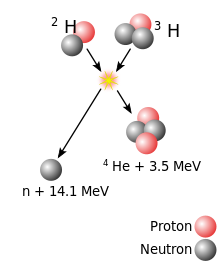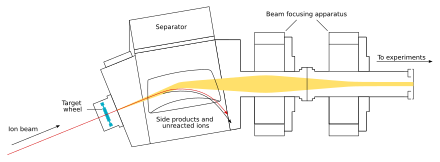Unbibium
[15] The definition by the IUPAC/IUPAP Joint Working Party (JWP) states that a chemical element can only be recognized as discovered if a nucleus of it has not decayed within 10−14 seconds.
This value was chosen as an estimate of how long it takes a nucleus to acquire electrons and thus display its chemical properties.
[j] Two attempts were made to synthesize unbibium in the 1970s, both propelled by early predictions on the island of stability at N = 184 and Z > 120,[47] and in particular whether superheavy elements could potentially be naturally occurring.
[48] The first attempts to synthesize unbibium were performed in 1972 by Flerov et al. at the Joint Institute for Nuclear Research (JINR), using the heavy-ion induced hot fusion reactions:[48] Another unsuccessful attempt to synthesize unbibium was carried out in 1978 at the GSI Helmholtz Center, where a natural erbium target was bombarded with xenon-136 ions:[48] No atoms were detected and a yield limit of 5 nb (5,000 pb) was measured.
Following a similar unsuccessful attempt to synthesize unbiunium from 238U and 65Cu, it was concluded that half-lives of superheavy nuclei must be less than one microsecond or the cross sections are very small.
[50][51] In 2000, the Gesellschaft für Schwerionenforschung (GSI) Helmholtz Center for Heavy Ion Research performed a very similar experiment with much higher sensitivity:[48] These results indicate that the synthesis of such heavier elements remains a significant challenge and further improvements of beam intensity and experimental efficiency is required.
Several experiments studying the fission characteristics of various superheavy compound nuclei such as 306Ubb were performed between 2000 and 2004 at the Flerov Laboratory of Nuclear Reactions.
[48] A criticism of the technique, previously used in purportedly identifying lighter thorium isotopes by mass spectrometry,[54] was published in Physical Review C in 2008.
[56] A repeat of the thorium experiment using the superior method of accelerator mass spectrometry (AMS) failed to confirm the results, despite a 100-fold better sensitivity.
[3] Current understanding of superheavy elements indicates that it is very unlikely for any traces of unbibium to persist in natural thorium samples.
Scientists largely ignore this naming convention, and instead simply refer to unbibium as "element 122" with the symbol of (122), or sometimes even E122 or 122.
[65] These reactions approached the limit of current technology; for example, the synthesis of tennessine required 22 milligrams of 249Bk and an intense 48Ca beam for six months.
Various models predict increasingly short alpha and spontaneous fission half-lives for isotopes with Z = 122 and N ~ 180 on the order of microseconds or less,[68] rendering detection nearly impossible with current equipment.
[69] For these reasons, other methods of production may need to be researched such as multi-nucleon transfer reactions capable of populating longer-lived nuclei.
[51] Nevertheless, several fusion-evaporation reactions leading to unbibium have been proposed in addition to those already tried unsuccessfully, though no institution has immediate plans to make synthesis attempts, instead focusing first on elements 119, 120, and possibly 121.
Because cross sections increase with asymmetry of the reaction,[51] a chromium beam would be most favorable in combination with a californium target,[50] especially if the predicted closed neutron shell at N = 184 could be reached in more neutron-rich products and confer additional stability.
This concept, proposed by University of California professor Glenn Seaborg, explains why superheavy elements last longer than predicted.
Additionally, spontaneous fission is expected to become a major decay mode in this region, with half-lives on the order of femtoseconds predicted for some even–even isotopes[68] due to minimal hindrance resulting from nucleon pairing and loss of stabilizing effects farther away from magic numbers.
Additionally, the isotopes 308–310Ubb are predicted to have half-lives under 1 microsecond,[68][77] too short for detection as a result of significantly lower binding energy for neutron numbers immediately above the N = 184 shell closure.
[74] However, these predictions are strongly dependent on the chosen nuclear mass models, and it is unknown which isotopes of unbibium will be most stable.
Regardless, these nuclei will be hard to synthesize as no combination of obtainable target and projectile can provide enough neutrons in the compound nucleus.
Unbibium is predicted to be similar in chemistry to cerium and thorium, which likewise have four valence electrons above a noble gas core, although it may be more reactive.
Additionally, unbibium is predicted to belong to a new block of valence g-electron atoms, although the 5g orbital is not expected to start filling until about element 125.




